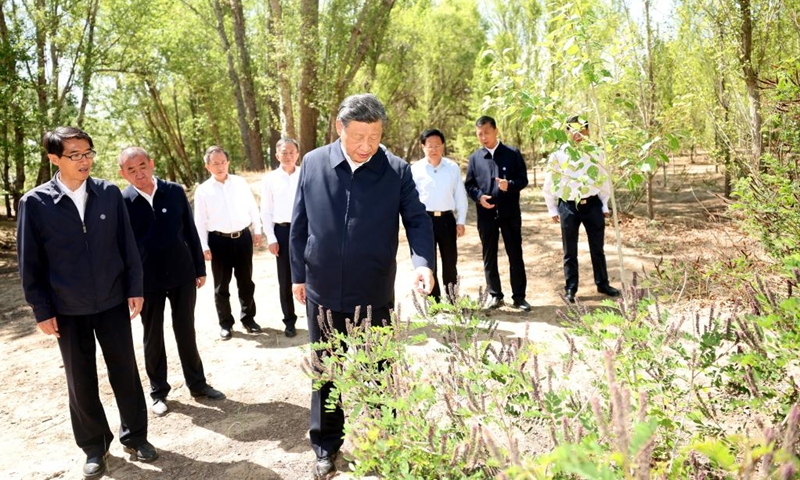Xi’s footprint in Inner Mongolia highlights China’s top-down effort in combating desertification

General Secretary of the Communist Party of China (CPC) Central Committee Xi Jinping, also Chinese president and chairman of the Central Military Commission, visits a state forestry area in Linhe District of Bayannur, north China's Inner Mongolia Autonomous Region, June 6, 2023.(Photo: Xinhua)
For mankind to have a better life and enjoy sound development, work must be done in combating desertification. Just like rolling a large rock uphill, endeavor in this regard may fall into relapse if any negligence occurs, said Xi Jinping, general secretary of the Communist Party of China (CPC) Central Committee, Chinese president and chairman of the Central Military Commission, at a symposium on strengthening comprehensive prevention and control of desertification and promoting the construction of key ecological projects in North China's Inner Mongolia Autonomous Region on June 6.
The president's inspection tour to Inner Mongolia has again highlighted his long-term focus on desertification. Experts said this top-down effort has made China's achievement unique in the world in tackling this environmental challenge.
From June 5 to 6, accompanied by officials from Inner Mongolia Autonomous Region, Xi was on a fact-finding mission at a nature reserve, a modern agricultural demonstration park, a forest farm and a water resources department in Bayannur.
On June 6, Xi presided over a symposium in the city of Bayannur on strengthening the comprehensive prevention and control of desertification and promoting the construction of crucial ecological projects, including the Three-North Shelterbelt Forest Program (TSFP).
After over 40 years of unremitting efforts, China has made remarkable achievements in preventing and controlling desertification, and realized a historic transformation from "sand forcing humans to retreat" to "trees forcing sand to retreat" in key areas, Xi said during a speech at the symposium.
Economic and social development, as well as the ecological outlook in desertification-threatened areas, have undergone earth-shaking changes, Xi said, adding that the hazards of sandstorms and soil erosion have been effectively curbed.
Sandstorms have hit north China more frequently in the past two years because of abnormal weather conditions and climate change.
Inner Mongolia has been at the frontline of desertification, but President Xi's speech emphasized the effort in curbing desertification, and pointed out the scientific and effective way to achieve the goal, an official who attended the symposium told the Global Times.
He said the next step is to speed up green transition in the region, to implement the TSFP projects, and to coordinate the tasks of returning farmland to forest and return some farm and grazing lands to a state of grassland.

Tens of thousands of Tadorna ferruginea birds fly in winter in Bayannur, Inner Mongolia. Photo: IC
Top-down effort
Improving the ecological environment has always been discussed by President Xi. During the two sessions in 2022, Xi told lawmakers from Inner Mongolia that the region should unswervingly prioritize ecological conservation and boost green development.
Xi has conducted multiple field trips to areas severely hit by sand damage, including Ningxia, Gansu, and Hebei.
During a 2019 inspection tour to Babusha Forest Farm in the northwestern province of Gansu, he joined local people plowing the sandy land. Using a trench digger skillfully, Xi plowed a two-meter-long trench in the sandy area with the workers in a few moments.
Babusha Forest Farm, located in Northwest China's Gansu Province, had long been plagued by severe sandstorms. After years of sand control, the formerly dry and barren land is now covered by vegetation.
Seeing the enormous transformation in this place, Xi praised the workers as being like a "modern-day Yu Gong" for their persistent efforts in controlling sand and transforming the desert into an oasis. Yu Gong, the protagonist of an ancient folk tale, tried to move mountains blocking the path in front of his home and eventually succeeded.
The desertification area in China has been reduced by more than 4.33 million hectares since 2012. A series of significant projects gradually built a green ecological barrier along the sandstorm line in northern China. In particular, the three primary sandy areas of Maowusu, Hunshandake, and Horqin, and the surrounding areas of the Kubuqi Desert, have been transformed into an oasis, according to documents sent to the Global Times by the National Forestry and Grassland Administration last week.
By 2025, China will have a total of 2 million hectares of land of desertification sealed off for protection, with more than 6 million hectares of sandy land newly treated and 1.3 million hectares of rocky and degraded land harnessed, said the administration.
Talking about China's success in tackling desertification in recent years, Yang Fuqiang, a senior advisor on climate change and energy transition with the Energy Research Institute at Peking University, told the Global Times that "China has made top-down efforts for years to address desertification. The central and local governments march together toward the same goal, with continuous environmental policies."
Such seamless cooperation has led to miraculous achievements, making China's effort in this area unique in the world, said Yang.

The Maowusu Desert, in North China's Inner Mongolia Autonomous Region, uses an upgraded ecosystem. Photo: IC
Intl cooperation urgently needed
During his inspection tour, Xi also called for efforts to extensively carry out international exchanges and cooperation, fulfill the United Nations Convention to Combat Desertification, actively participate in global desertification control and environmental governance, place strong emphasis on cooperation with neighboring countries, support desertification control and prevention efforts in countries along the route of the Belt and Road Initiative, lead countries in policy dialogue and information sharing, and jointly respond to sand and dust storm disasters.
The sandstorms in North China this year were partly trigged by sparse rainfall, and sand damage to plant cover in Mongolia, experts explained.
When meeting with President Ukhnaagiin Khurelsukh of Mongolia in Beijing in November 2022, Xi said that China applauds Mongolia's "Billion Trees" initiative, and is ready to discuss with Mongolia the establishment of a cooperation center to combat desertification.
Last year, China and Mongolia signed bilateral documents jointly addressing climate change, desertification and other areas. China held an online seminar to share with Mongolia its experience in addressing desertification in Kubuqi Desert in China's Inner Mongolia Autonomous Region, according to media reports.
China and Mongolia have always cooperated in managing sand and dust, but China could also aid Mongolia with experience and technology. Every year, funding from Chinese government departments and the United Nations Convention to Combat Desertification is applied for this, the Global Times learned from the Chinese Academy of Forestry.
Cao Xiaoming, a research fellow at the Institute of Desertification Studies under the Chinese Academy of Forestry, told the Global Times that his team monitored drought conditions in the Mongolian Plateau from 2011 to 2018 with remote-sensing techniques, together with scientists in Mongolia.
They found how climate change and human activities have led to dryer earth and desertification in the region, which covers both Mongolia and China's Inner Mongolia. According to Cao, the research is funded by the Chinese side. The results of the research are shared with Mongolian institutes.
Ma Jun, director of the Beijing-based Institute of Public and Environmental Affairs, said the more frequent sandstorms in North China in recent years highlighted the urgency for China and Mongolia as well as other neighboring countries to continue their joint efforts to combat desertification.
A sandstorm is a natural phenomenon that knows no boundaries and can be transmitted via all kinds of routes, said Ma. He said that addressing the problem requires transparent sharing of information and mutual trust, as well as joint efforts from countries in the region.


